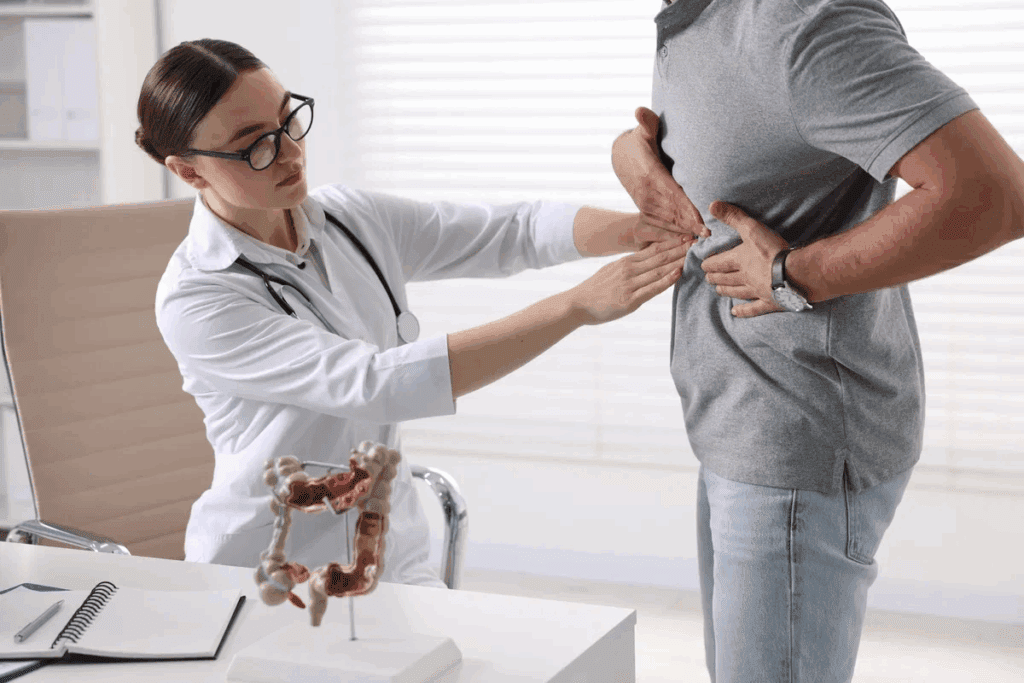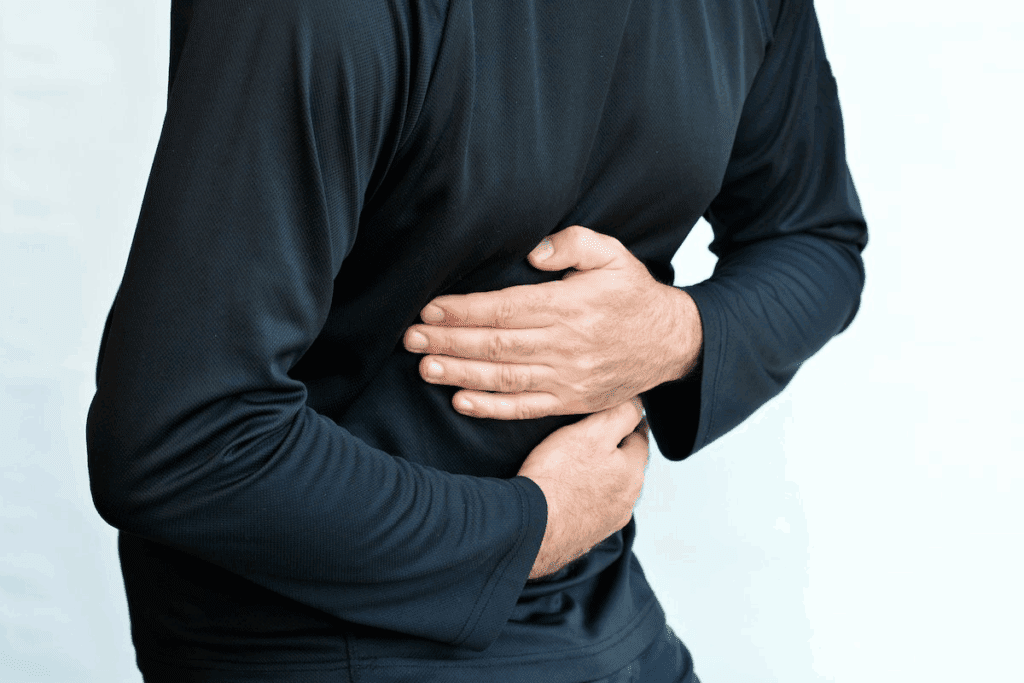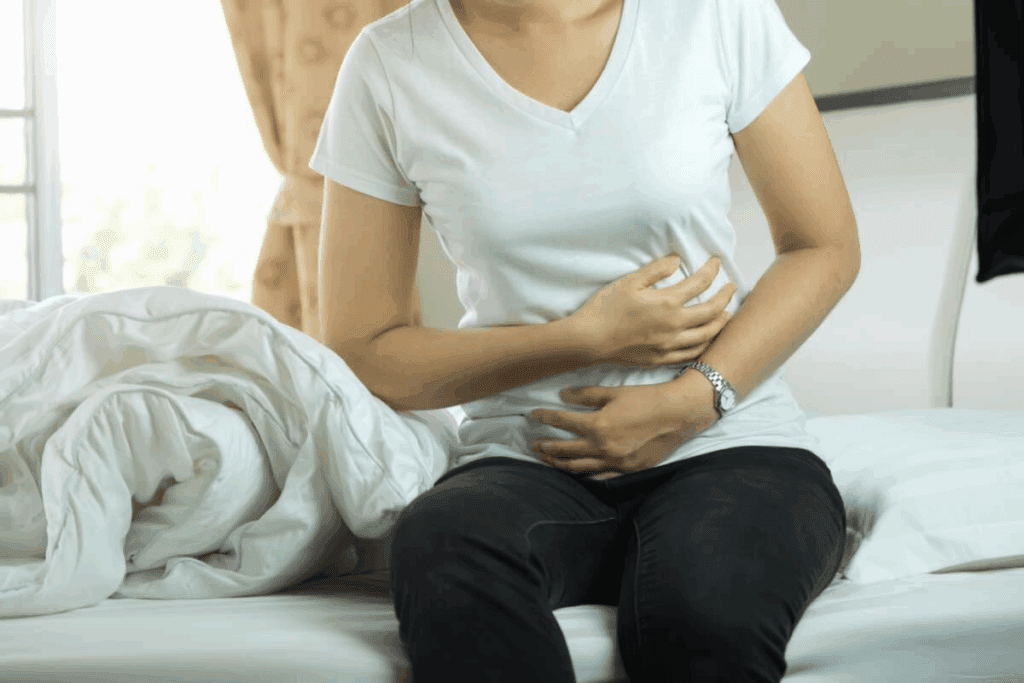Last Updated on November 26, 2025 by Bilal Hasdemir

Gallbladder inflammation can surprise people in many ways. It’s surprising to learn that gallbladder issues can cause shoulder pain.
The gallbladder holds bile from the liver. When it gets inflamed, it leads to acute cholecystitis. This can cause serious problems if not treated quickly.
Gallbladder disease and shoulder pain are linked. Get 7 surprising facts about referred pain, inflammation, and key symptoms.
It’s important to know how gallbladder disease and its symptoms, like shoulder pain, work together. This knowledge helps doctors act fast.

The gallbladder is a key part of the biliary system. It stores and concentrates bile, which is vital for digestion.
The gallbladder is a small, pear-shaped organ. It sits just under the liver. Its anatomical position lets it get bile directly from the liver via the cystic duct. Knowing where it is helps us understand how it works in digestion.
The main job of the gallbladder is bile storage. It holds bile made by the liver until it’s needed in the small intestine. There, it helps with fat digestion.
Bile salts make fats easier for enzymes to break down. This way, the body can absorb them better.
| Function | Description |
| Bile Storage | Stores bile from the liver |
| Digestion Aid | Releases bile to emulsify fats |
| Concentration of Bile | Concentrates bile for more effective digestion |
Inflammation of the gallbladder, often due to gallstones, can cause severe pain. It can also lead to serious problems. Knowing how the gallbladder aids digestion shows its critical role.

Gallbladder disease covers several issues with the gallbladder, a key part of our digestive system. It stores bile, a liver-made fluid that helps digest fats.
Different conditions, from inflammation to blockages, can affect our digestive health. Knowing about these is key for the right treatment.
Gallbladder problems fall into categories based on their causes and symptoms. The main types are:
These issues can happen with or without gallstones. For example, acute cholecystitis can occur without stones, often due to severe illness or infection.
Gallbladder issues can be sudden or long-lasting. Acute cholecystitis is a sudden inflammation needing quick medical help. It can happen with or without gallstones.
Chronic gallbladder disease has recurring symptoms over time. This can cause scarring and thickening, making the gallbladder less functional.
| Characteristics | Acute Gallbladder Disease | Chronic Gallbladder Disease |
| Onset | Sudden | Gradual or recurring |
| Duration | Short-term | Long-term |
| Symptoms | Severe pain, fever, jaundice | Mild to moderate pain, indigestion |
| Treatment | Often requires hospitalization and surgery | May involve lifestyle changes, medication, or surgery |
Shoulder pain can be a surprise symptom of gallbladder disease. It comes from the body’s complex nerve network. While belly pain is common with gallbladder problems, shoulder pain is also a key symptom to watch for.
Referred pain happens when pain feels like it’s coming from somewhere else. For gallbladder disease, pain can go to the right shoulder. This is because the nerves in the gallbladder and shoulder share the same roots.
This is thanks to the phrenic nerve. It’s important for sending pain signals.
The phrenic nerve comes from the neck and connects to the diaphragm. The diaphragm is near the gallbladder. When the gallbladder gets inflamed, like in acute cholecystitis, the phrenic nerve gets irritated.
This irritation causes pain in the shoulder. People often feel a dull ache or sharp pain.
Irritation of the phrenic nerve is a main reason for shoulder pain from gallbladder disease. Knowing this helps doctors diagnose and treat the pain’s cause.
Shoulder pain linked to gallbladder disease often comes with other signs. These include belly pain, nausea, and vomiting. It’s important to see the link between shoulder pain and gallbladder problems for quick medical help.
If you have ongoing or severe shoulder pain, and other gallbladder symptoms, get checked by a doctor.
In summary, the link between gallbladder disease and shoulder pain is complex. It involves referred pain and the phrenic nerve. Knowing about this connection helps find and treat gallbladder disease early.
Knowing what causes gallbladder inflammation is key to treating it. This condition, called cholecystitis, can come from several sources. Each source has its own impact on how we care for patients.
The main reason for gallbladder inflammation is when gallstones block the cystic duct. This blockage stops bile from flowing, causing inflammation and infection. This is called calculous cholecystitis.
Gallstones are hard, small pieces that form in the gallbladder. They can be made of cholesterol or bilirubin. When they block the cystic duct, they stop bile from draining, causing inflammation.
Bacterial infections can also lead to gallbladder inflammation. This is more likely if the gallbladder is already damaged by gallstones or other issues. Bacteria can move up from the bile ducts into the gallbladder, causing infection and inflammation.
Trauma to the abdomen can also cause gallbladder inflammation. Other rare reasons include severe illness, long fasting, or certain medicines that affect the gallbladder.
In some cases, the gallbladder can get inflamed without gallstones, known as acalculous cholecystitis. This can happen after severe illness, major surgery, or significant trauma. The gallbladder becomes inflamed due to bile stasis and ischemia.
It’s important to note that while gallstones are the main cause, inflammation without stones is more dangerous. This is because it often happens in very sick patients.
Several factors can increase the risk of gallbladder disease. These include obesity, metabolic disorders, and genetic predispositions. Knowing these risk factors is key to preventing and catching the disease early.
Being overweight is a big risk for gallbladder disease. It can lead to gallstones, a main cause of inflammation. Metabolic syndrome, linked to obesity, also raises the risk. Insulin resistance and dyslipidemia, parts of metabolic syndrome, add to the danger.
Diabetes also ups the risk of gallbladder disease. The connection is thought to be due to diabetes’s metabolic issues, like insulin resistance. People with diabetes often have other risk factors, like obesity, that make gallbladder disease more likely.
Quick weight loss, through dieting or surgery, raises gallstone and gallbladder disease risk. This is because it can cause cholesterol gallstones. Eating too much saturated fat and cholesterol also increases the risk.
Age, gender, and genetics also affect gallbladder disease risk. The risk grows with age, and women are more at risk, mainly during their childbearing years. Some ethnic groups are more prone to gallbladder disease, showing a genetic link.
Knowing these risk factors helps people take steps to prevent gallbladder disease. By managing obesity and diabetes, and being mindful of gallbladder disease risk, individuals can lower their chances of getting it.
Upper abdominal pain is a key sign of gallbladder disease. It feels like severe discomfort in the upper right or center of your abdomen. This pain is linked to conditions like cholecystitis, where the gallbladder gets inflamed.
Gallbladder pain, or biliary colic, starts suddenly and can be very severe. It usually happens in the upper right abdomen but can spread to the back or right shoulder. People often describe it as sharp, crampy, or feeling like pressure.
The pain from gallbladder issues can change, but it often:
The timing and length of gallbladder pain episodes can help figure out what’s wrong. Pain from gallbladder disease can happen at any time but often starts after eating, specially fatty foods.
Typically, episodes of biliary colic:
Telling gallbladder pain apart from other stomach issues is key for the right diagnosis and treatment. Problems like peptic ulcers, pancreatitis, or even heart issues can have similar symptoms.
“The key to diagnosing gallbladder disease lies in understanding the pattern and characteristics of the pain, as well as associated symptoms.”
To tell gallbladder pain from other causes, doctors look at:
Nausea and vomiting are common signs of gallbladder disease. They signal a gallbladder attack. These symptoms can make daily life uncomfortable.
The gallbladder is key for storing and releasing bile. When it’s not working right, you might feel sick to your stomach. This is because bile flow is disrupted.
Bile helps break down fats. If the gallbladder is inflamed or blocked, it can’t release bile. This makes it hard to digest fats, leading to intolerance to fatty foods. Eating fatty foods can then cause nausea and vomiting.
People with gallbladder disease often feel bad after eating fatty foods. The gallbladder can’t release enough bile to digest fats. So, eating fatty foods can cause nausea, vomiting, and other stomach problems.
Nausea and vomiting are common in gallbladder disease. But, they can also mean something serious is happening. If these symptoms are very bad, don’t go away, or if you have a fever or jaundice, get help right away.
Severe cases might need emergency care. This is to avoid serious problems like gangrene or a hole in the gallbladder. It’s important to see a doctor quickly to figure out what’s wrong and how to fix it.
Pain that gets worse with deep breathing is a key sign of gallbladder inflammation. This symptom is worrying because it might mean the diaphragm is irritated. The diaphragm is a muscle that helps us breathe.
The diaphragm is a dome-shaped muscle that divides the chest and abdominal cavities. When the gallbladder gets inflamed, it can irritate the diaphragm. This leads to pain that gets worse with deep breathing or movement.
It’s important to tell the difference between pain from gallbladder disease and respiratory issues. Respiratory problems like pneumonia can also cause pain with deep breathing. But gallbladder disease often comes with nausea and pain in the right upper abdomen.
The pain from deep breathing can show how bad the gallbladder inflammation is. More severe inflammation irritates the diaphragm more. This results in more pain when you breathe deeply.
| Symptom | Gallbladder Disease | Respiratory Conditions |
| Pain with Deep Breathing | Often accompanied by right upper quadrant abdominal pain | Typically associated with cough, fever, or shortness of breath |
| Nausea and Vomiting | Common, specially after fatty meals | Less common, but can occur |
| Abdominal Tenderness | Localized to the right upper quadrant | Usually not a primary symptom |
Understanding pain worsened by deep breathing helps diagnose gallbladder disease. It’s different from other conditions. If you have persistent or severe pain, see a doctor for help.
Acute cholecystitis, or inflammation of the gallbladder, often shows fever and chills. This is a serious condition that needs quick treatment.
The inflammation in acute cholecystitis raises white blood cell count, causes fever, and shows other signs of inflammation. Fever is a key sign of an infection that needs quick medical check-up.
“Fever and chills should not be ignored,” says a top gastroenterologist. “They can mean a serious infection that could get worse if not treated right away.”
Gallbladder infections start when bacteria move from the bile duct into the gallbladder. Bacterial infection can make gallbladder disease worse, causing more severe symptoms and serious health risks.
If not treated, gallbladder infections can cause gangrene, perforation, or sepsis. Quick action to treat infection signs is key to avoid these dangers.
Fever, chills, and other infection signs need quick medical attention to avoid serious problems.
Jaundice, which makes the skin and eyes turn yellow, is a key sign of gallbladder disease. It happens when bile flow is blocked. This blockage can be caused by gallstones or other issues with the bile ducts.
Jaundice often comes from bile duct obstruction. This means bile can’t move from the liver to the intestine. Gallstones or other problems can block the bile ducts. When bile builds up in the blood, it turns the skin and eyes yellow.
Jaundice can get worse over time if not treated. At first, the yellow color might be slight. But as the blockage gets worse, the color gets darker. Finding the cause of jaundice is key to stopping it from getting worse.
Other signs can happen when bile can’t flow right. These include dark urine, pale stools, and itching. These symptoms happen because bile salts build up in the blood and tissues. Spotting these signs can help figure out what’s wrong with the gallbladder.
It’s important to understand how jaundice, skin color changes, and bile duct blockage are linked. If you notice jaundice, getting medical help right away is vital. This can help fix the problem and avoid serious issues.
Getting a correct diagnosis for gallbladder disease is key to effective treatment. It starts with a detailed medical history and physical check-up. Then, tests are done to confirm the disease and its extent.
Imaging tests are essential in diagnosing gallbladder disease. Ultrasound is often the first choice because it’s very good at finding gallstones and is non-invasive. Other tests like CT scans and MRI might be used to get a closer look at the gallbladder and bile ducts.
Laboratory tests, like liver function tests and complete blood counts, help see how severe the disease is. They can also spot complications early on. For example, high liver enzyme levels might show a bile duct blockage.
| Diagnostic Test | Purpose |
| Ultrasound | Detects gallstones and evaluates gallbladder inflammation |
| CT Scan | Assesses the gallbladder and bile ducts for complications |
| Liver Function Tests | Evaluates liver enzyme levels to identify bile duct obstruction |
Medical treatment for gallbladder disease aims to ease symptoms and manage complications. For mild cases, treatment might include pain relief and dietary changes to prevent gallstones.
For acute cholecystitis, hospital care is needed for antibiotics and fluids. Those with recurring or severe disease might need more serious treatments.
Laparoscopic cholecystectomy is the main surgery for gallbladder disease. It removes the gallbladder through small cuts. This method usually leads to faster recovery than open surgery.
Recovery from this surgery takes a few weeks. Patients might feel some pain and need to follow a special diet. Most can get back to their usual activities soon after.
It’s important to know the signs of gallbladder disease to get medical help quickly. Look out for upper abdominal pain, nausea, and fever. These symptoms can lead to serious problems if ignored.
If your gallbladder symptoms don’t go away or get worse, you need to see a doctor right away. Waiting too long can cause serious issues like gangrene or a hole in the gallbladder.
Don’t hesitate to visit your doctor if you’re worried about your symptoms. They can check you out and tell you what to do next.
Knowing the symptoms of gallbladder disease and when to get help is key to getting better. Stay informed and take care of your health to avoid problems.
The gallbladder can get inflamed for several reasons. Gallstones, bacterial infections, or trauma are common causes. Sometimes, inflammation happens without stones, known as acalculous cholecystitis.
Acute cholecystitis is a sudden inflammation of the gallbladder. It’s often caused by gallstones blocking the cystic duct. This can lead to severe pain, fever, and serious complications if not treated quickly.
Yes, gallbladder disease can cause shoulder pain. This happens because of irritation of the phrenic nerve. This nerve runs from the neck to the diaphragm and can send pain signals to the shoulder when the gallbladder is inflamed.
Several factors increase the risk of gallbladder disease. Obesity, diabetes, rapid weight loss, and certain diets are risk factors. Age, gender, and genetics also play a role.
Doctors use imaging tests like ultrasound, CT scans, or MRI to diagnose gallbladder disease. They also check for signs of infection or inflammation with lab tests. A physical exam and medical history review are part of the diagnosis.
Symptoms include upper abdominal pain, nausea, vomiting, and pain that worsens with deep breathing. Fever, chills, jaundice, and skin discoloration are also symptoms. The severity and type of symptoms vary based on the condition.
Yes, untreated gallbladder disease can be deadly. It can lead to gangrene, perforation, or sepsis. Quick medical attention is key to prevent these serious outcomes.
Treatment may include antibiotics, pain management, and dietary changes. Sometimes, surgery to remove the gallbladder is needed, mainly for severe or recurrent cases.
Inflammation without stones, known as acalculous cholecystitis, can be caused by bacterial infections, trauma, or other factors. It’s often seen in critically ill patients or those with certain medical conditions.
The gallbladder can get infected when bacteria enter it, often due to blockage by gallstones. This can lead to acute cholecystitis, a serious condition.
REFERENCES:
Subscribe to our e-newsletter to stay informed about the latest innovations in the world of health and exclusive offers!